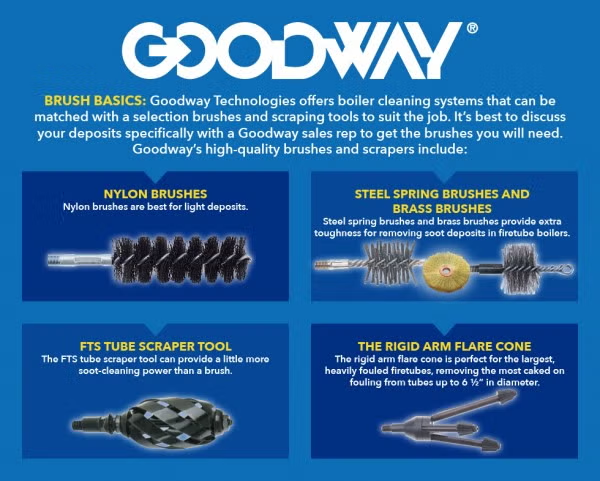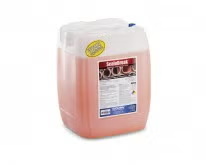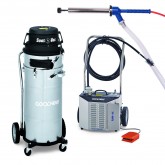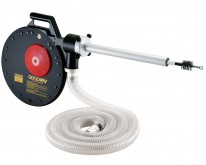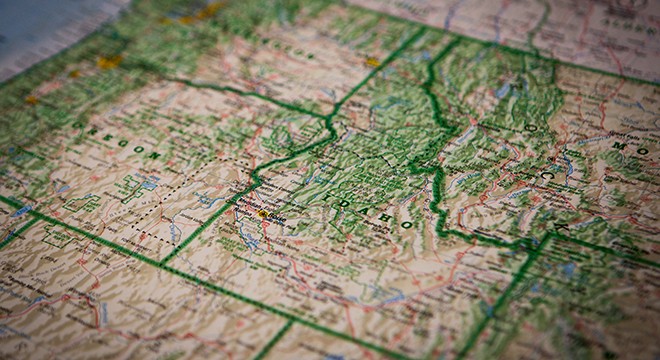Boiler Tube Cleaning Tools Buying & Cleaning Guide
A modern boiler cleaning system could be your best investment for cleaning boiler tubes in firetube and watertube boilers. Clean tubes improve efficiency and increase equipment life. When selecting a boiler cleaning system, it’s critical to right-size your purchase for the task at hand to get the best results.
When considering or purchasing a boiler cleaning system, run through this buying guide to help determine your exact need.
What is Boiler Cleaning?
HVAC equipment, including boilers, should never be neglected and must be on a preventative maintenance plan that includes tuning, regular cleaning, and descaling. All boilers have two “sides” that need to be cleaned. One side is the “fireside” that contains the combustion of gas, oil, or other fuel. The second side, the “waterside,” is filled with water that absorbs the heat of combustion before being pumped through the pipes to provide heat or process steam to the building.
Boiler Cleaning Choices: Should I Use Mechanical or Chemical Cleaning?
Mineral deposits or “scaling” can form on the boiler’s waterside, inhibiting water flow and heat transfer. Scale is removed through either mechanical or chemical cleaning methods. Mechanical cleaning removes scale with the use of tools like scrapers, brushes, or sandblasters. Chemical scale removal uses acids or another liquid descaler to dissolve the minerals through a chemical reaction between the scale and the liquid. The method used for cleaning, mechanical or chemical, differs depending on the thickness and type of deposits being removed.
The severity of fire tube corrosion and fouling is related to the fuel being burned. Natural gas, propane, and petroleum fuels like gasoline or No. 2 diesel fuel produce a light fouling removed by brushes without the need for heavy scrapers. Boilers burning wood, medical or municipal waste, and heavy petroleum fuels like No. 6 fuel oil often suffer from thick fouling that can only be removed by a powerful cleaning system with strong brushes and scraping tools.
Soot and corrosion from combustion can foul the fireside of boilers, causing tube wall temperature to get so hot that the tube itself weakens and can rupture. Fireside fouling can be mechanically removed with rods and brushes, compressed air, bead blasting, or more advanced technology like motor-driven rotary brush cleaners.
Did You Know
Goodway offers personalized boiler descaling calculators on their website to help identify how much you could be saving by descaling your boilers. Try them yourself here.
Goodway Technologies offers boiler cleaning systems that can be matched with a selection of brushes and scraping tools to best match the job. It’s best to discuss your deposits specifically with a Goodway sales rep to best match the brushes you will need. Goodway’s high-quality brushes and scrapers include:
Nylon brushes are best for light deposits. Steel spring brushes and brass brushes provide extra toughness for removing soot deposits in fire tube boilers. When you need just a little more soot-cleaning power than a brush can provide, the FTS tube scraper tool will get the job done. For the largest, heavily fouled fire tubes, nothing comes close to the cleaning strength of Goodway’s rigid arm flare cone that removes the most caked-on fouling from tubes up to 6 ½” in diameter. See our brush basics infographic.
Choosing the correct boiler cleaning system is informed by the boiler you have, the severity and fouling to be removed, and system features like portability and power.
How do you clean a boiler tube?
Cleaning a boiler tube is dependent on the amount and type of deposits in the tubes, and where on the tube structure the deposits exists. For tube deposits in firetube boilers caused by combustion, an automated brush cleaner is best. The boiler tube cleaning device pushes or rotates a brush down the tube, and an integrated vacuum removes soot.
For mineral based deposits formed on the water “side” of the tube, chemical scale removal is recommended. A product like ScaleBreak can be circulated around the tubes and it will dissolve the mineral deposits safely.
How often should you clean your boiler tubes?
The frequency at which you perform regular boiler tube maintenance is largely dependent upon the environmental conditions in which your system operates. The best way to determine whether boiler tube maintenance is required is through regular testing of your system's efficiency. An increase in stack temperature is a good indicator that maintenance is required. Goodway's Stack Efficiency Tester measures O2, CO, and CO2 as well as excess air and combustion efficiency. It provides on-the-spot data as you're making adjustments to the boiler. Quality testing equipment can also alert you to other problems, such as dirty burners, bad drafting, fouling, flame impingements, and improper firing ratios. With proper testing and regular maintenance using the current state-of-the-art boiler tube maintenance equipment and boiler tube cleaning brushes, HVAC professionals can operate efficient systems with reduced fuel consumption over longer periods of time, all of which contribute to lower operating costs for maintenance contracts.
Why do boiler tubes need to be cleaned so often?
- Simply put. Dirty boiler tubes cost money, Lots of money. Reduced efficiency increases the amount of fuel needed to heat the water and therefore can cost drastically more. Preventative measures are mandatory to ensure that your boiler tubes are operating in an optimal, clean state. Boiler tube deposits can result in substantial negative impacts on fuel consumption and system life:
- Soot has five times the insulating capacity of asbestos.
- The cost of repairs can be 10 times that of preventative maintenance
A half-inch of scale deposits can increase fuel usage by 70%.
Cleaning boiler tubes regularly will lower costs by reducing fuel consumption, increasing output and minimizing detrimental wear and tear that can shave years off heating system life. Additionally, with today's high-efficiency systems, routine maintenance is even more crucial. Both firetube and watertube boilers are susceptible to reduced efficiency due to the build-up deposits. Increased stack temperatures can substantially inhibit boiler tubes and system efficiency. Fortunately, with the state of today's boiler tube cleaning technology and Goodway’s boiler tube cleaning brushes, it can take as little as an hour to descale a boiler. That wasn't always the case.
Learn About Boiler Tube Cleaning Tools
For customers concerned with cleaning watertube boilers, Goodway makes the Models AWT-100 and AWT-100X air-powered boiler tube cleaners. The AWT-100 model is compact enough to fit through the manhole in the steam drum of a watertube boiler. They operate on compressed air for safety reasons – the operator is surrounded by metal when working inside the boiler and metal, water and electricity do not mix.
AWT-100 Rotary Boiler Tube Cleaner
Cleaning water tube boilers are challenging because cleaners must climb into the mud drum to access the tubes. There is usually very little room inside the mud drum for the technician to work, much less to bring in heavy and bulky cleaning equipment. To make cleaning water tubes easier, Goodway Technologies developed the AWT-100 Cleaning System. Weighing just 29 pounds dry and only 10 3/8” x 6” x 19” in size, technicians can easily bring the tube cleaner in the mud drum to perform the tube cleaning. The AWT-100’s air-powered motor gives this tiny cleaner a powerful punch to scrape away even the toughest scale and debris in water tube boilers or heat exchangers.
A variety of aggressive cleaning tools are offered for use with the AWT-100 which is capable of cutting through tough water scale even in curved tubes. Goodway has a boiler tube cleaning system to serve all of your different boiler tube cleaning applications, from light to heavy-duty.
AWT-100X Rotary Boiler Tube Cleaner
No cleaning system beats the AWT-100X’s versatility for cleaning water tube and fire tube boilers or heat exchangers. The unit can be used in wet or dry conditions, and the incredible air-powered 4HP motor has the strength to clean any fouling from tubes or pipes
¼” and above. For dry applications, the GTC-DPA Dry Pickup Attachment and a simultaneous vacuum are used to remove loosened deposits all in one system. Everything you need for tube cleaning is within easy reach inside the integral tool storage box. Because the AWT-100X is wheel-mounted for maximum portability, roll it to the next location when the cleaning is complete.
RAM-4X Rotary Boiler Tube Cleaner
Goodway offers the Models RAM-4X and RAM-4X2A Ream-A-Matic® for conditions where a straight brushing action is insufficient in removing scale. Rather than using the simple in/out action of the Soot-A-Matic®, the RAM-4X uses an electric motor to drive a rotating flexible shaft encased in a non-rotating casing. A variety of more aggressive cleaning tools ranging from stiff brushes to various cutting tools, buffers, and hones are available. The rotation of the tools coupled with their aggressive cleaning action makes short work of scale removal. The flexible shaft is fed through a special dry pick-up attachment that is connected to the GTC-540 vacuum for simultaneous removal of deposits.
Neglected boilers, especially those that burn wood, medical waste, or No. 6 fuel oil, need a powerful machine to scrape soot and fouling out the tubes. The 1HP RAM-4X uses a Quick Connect rotary shaft fitted with different sized wire brushes or scrapers to remove years of buildup. When connected with the GTC-540 industrial vacuum, loosened soot and debris are sucked out of the tube into the vacuum eliminating the incredible mess that usually comes with cleaning soot-filled fire tubes.
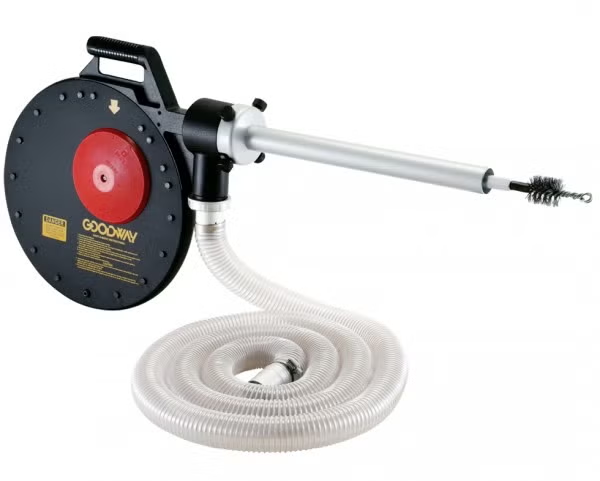
SAM-3 Boiler Tube Cleaner
Goodway's featured boiler tube cleaning system, the Soot-A-Matic, was introduced over 35 years ago. Now in its third generation as the SAM-3, it is the world's most popular system for cleaning firetube boilers.
Goodway’s original SAM firetube boiler punching machine has stood the test of time and continues to be the workhorse of the tube cleaning industry. The SAM-3 is a compact, easy-to-use straight punch machine best for natural gas and light petroleum fuels in its third generation.
A trigger-controlled tape with a cleaning tool mounted on the end can extend up to 26 feet through the length of even the longest boiler tubes. The operator pulls the trigger back to return the cleaning tool and moves on to the next tube. Brushes and scrapers can be switched, giving users maximum flexibility to clean a wide range of boiler sizes.
When you connect a GTC-540 Soot-Vac Vacuum to the SAM-3, loosened deposits are simultaneously drawn out of the tube as the tube is cleaned. A full range of accessories is available including interchangeable bayonet nozzles, steel brushes and cleaning tools to fit your boiler tubes. Goodway boiler tube cleaning systems are constructed with spring steel tape for long life. With the increasing use of waste heat boilers and the use of less highly refined fuels that do not burn as cleanly such as used crankcase oil, scale in boiler firetubes has become a common headache for maintenance personnel. It is not uncommon for a straight brushing action to prove insufficient in removing scale from the tubes.
The waterside of a boiler is also at risk of fouling because minerals in the water collect on the internal surfaces during operation. All of Goodway’s descaling systems are simple to use and require very little work by maintenance staff. The technician fills the machine’s hopper with the descaling chemical, connects the hoses to the boiler or heat exchanger, and turns on the cleaning unit. Mineral solids dissolve as the descaling chemical passes across the hardened scale.
Did You Know?
Goodway's SAM firetube boiler punching machine has been a customer favorite for decades and is now in its third generation.
Learn About Scale Removal Systems
GDS-15-PH Descaler System
For maintenance staff who truly need a “set it and forget it” descaling system, there is no better machine than the GDS-15-PH. Similar to the GDS-100, but with fully autonomous operation. Once the GDS-15-PH is connected to the boiler or heat exchanger, the machine automatically mixes descaling chemicals and water and begins the circulation process. There is no need to check the pH of the return water mixture; the onboard computer monitors pH levels and turns the pump off when the pH reaches neutral. The wastewater can be safely poured down the drain after descaling.
GDS-C40 Descaler System
For service companies that need a portable descaling system for small commercial and residential boilers, water heaters, and condensing heaters the GDS-C40 is the unit of choice. At only 37 pounds dry, the GDS-C40 is light and easy to move from location to location. The most exciting feature in the GDS-C40 is the innovative Flow Reversal Valve. During the descaling process, lime scale dissolves and creates foam and gas, which acts as a barrier to further scale reduction. Using the Flow Reversal Valve allows for the foam and gas to discharge into the tank, eliminating the barrier effect and considerably speeding up the descaling process.
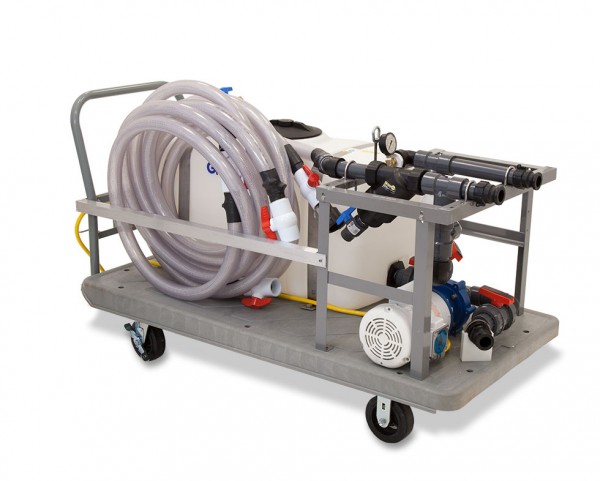
GDS-100 Descaler System
This unit combines size, pumping power, and portability in one mobile Clean In Place (CIP) system. The GDS-100 has a heavy-duty industrial design with a 50 gallon vented tank for big descaling projects. The 1HP pump motor provides 51 feet of head and the 25-foot hoses move 96 gallons per minute of descaler through even the dirtiest and most restricted boilers and heat exchangers. Once the system is running, technicians need only to monitor the cleaning and occasionally check pH levels to detect when scale removal has finished.
Learn The Basics of Chemical Descaling
ScaleBreak® Liquid Descaler
The chemicals in your descaling system are important not only to remove all the scale from your boilers and heat exchangers, but the chemicals should be safe to use, easy to dispose of, and comply with environmental regulations. ScaleBreak Liquid Descaler is fortified with powerful low- foaming, wetting, and penetrating agents and superior corrosion inhibitors to cut through years of caked-on scale and mineral deposits. Each gallon of ScaleBreak dissolves two pounds of scale from your heating equipment. Knowing descaling is not a one size fits all process, the ScaleBreak family has a variety of formulas including one for stainless steel.
Boiler Tube Cleaning with Ream-A-Matic 4x
Modern boiler tube cleaning equipment solves many of the problems of those early methods. Today's industrial HVAC maintenance tools are more effective at completing the tasks they were designed to tackle. They also cause substantially less impact on the environment. Additionally, they are much more versatile and can be operated with little or no training. Goodway customer Clifford Singletary expresses an often-shared sentiment about the state of modern boiler maintenance equipment
Technologically advanced boiler tube cleaners like Goodway's Ream-A-Matic 4X use a flexible shaft with a rotary cleaning tool to scour dust, debris, limescale, mud, and algae from a wide variety of pipes in a broad range of sizes. The flexible shaft uses an integrated water feed that flushes loosened deposits out of the system, performing two functions in one with a simple one-button operation.
A Brief History of Boiler Tube Cleaning
A retrospective look at boiler tube cleaning methods provides a unique appreciation for how far the technology has come both in terms of effectiveness and ease of operation. Not long ago, it was common for boiler tube cleaning methods to have serious environmental and occupational impacts that would never comply with today's strict regulations. Some techniques were effective at removing soot and scale from tubes but had the unintended consequence of depositing it on the surrounding workspace or dispersing it into the air. All too often, early tube-cleaning practices resulted in lengthy clean-up time that could take as long as or even longer than the actual tube cleaning. The first air-powered tools for water and boiler tube cleaning used a cutting head to loosen debris. Not only did this method require a separate debris-removal procedure, but it also required multiple cleaning units since most air motors operated only within a limited range of tube diameters.
Your boiler must be cleaned and maintained at the end of each heating season to remain reliable and energy efficient. Goodway’s complete line of boiler cleaning and descaling products adds life to your boiler and keeps it working effectively for years.
For more information on selecting the best boiler cleaner for the job, contact Goodway.

